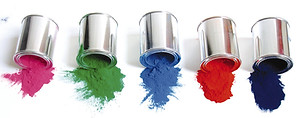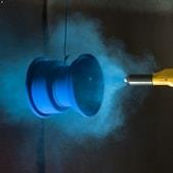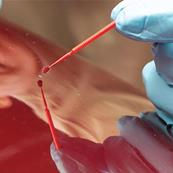

ABOUT POWDER COATING
Powder coating is a coating applied to metal products through a process known as electrostatic spray deposition (ESD). Powder coating is applied electrostatically as a dry, free-flowing powder through a spray gun which applies an electrostatic charge to colored powder particles that are grounded to the metal component. After the powder is applied, the component is then cured under heat to create a “skin” across the entire metal substrate.
The powder used in the coating process is either a thermoset polymer or thermoplastic. Unlike traditional liquid paint, powder coating does not require a solvent to maintain the fillers and binders in a liquid state. Powder coating is more durable than traditional paint and is typically used on industrial, commercial, residential, and automotive metal applications. Powder coating is available in a wide variety of colors and textures allowing for nearly limitless combination of customization options.
Properties of Powder Coating
Powder coating results in a thicker layer of a protective coating without runs or sags thanks to the fact that it does not contain a liquid carrier.
The lack of a liquid carrier also allows for a product to be vertically or horizontally coated and results in few volatile organic compounds (VOC) improving the environmental friendliness of powder coating. Finally, the dry powder coating process allows for several varying layers of color to be applied before curing providing a variety of bleed and blending effects in a single coating.
Thick, durable coatings, which cure to a smooth, texture-free coating, are easy to apply with powder coating due to its uniform electrostatic application. However, thin smooth coating layers are very difficult to
create with powder coating. As the thickness of the coating is reduced,

an orange peel texture effect will appear due to the glass transition temperature and particle size of the powder.
A professional commercial grade powder coating requires significant capital investments for the powder application guns and industrial ovens used to produce the final product. One benefit of powder coating is overspray can be recycled reducing material costs for jobs. However, if multiple powder colors are used for a coating, the ability to recycle your colors is limited.
Powder Coating Process
-
Part preparation / pre-treatment
-
Powder application
-
Baking / Curing
Pre-Treatment and Preparation
The first step in the powder coating process is metal preparation and pre-treatment to ensure a uniform and lasting application. Removing dirt, oil, old coatings, lubrication grease, metal oxide, rust, etc., is essential to ensure a proper coating. Preparation for powder coating is accomplished through a variety of mechanical and chemical methods. The best method is dependent on the size and condition of the product to be coated.

Chemical pre-treatment is accomplished through the use of chromates or phosphates which are typically sprayed on, or submersed around, the product to be coated. Cleaning is typically accomplished through a multi-staged process consisting of degreasing, de-smutting, rinsing, etching, chromating, or phosphating the substrate of the item. The intent of the pretreatment process is to clean and improve the bonding surface of the metal to powder. There are additional options for enhanced protect against corrosion in the pretreatment program such as silanes or Titanium zirconium. In many premium applications, metal parts are electrocoated following the pretreatment process and prior to the powder application. This process is particularly useful in automotive applications which demand high durability and performance characteristics.

The most common pretreatment process for powder coating is known as abrasive blasting also referred to as shot blasting, media blasting, or sandblasting. With media blasting, various forms of blast media or blast abrasives are utilized to prep the metal substrate surface through texturing, etching, finishing, and degreasing. Common materials used in the sandblasting process are silicon carbide, high-purity sand crystals, glass beads, and plastic media which is more suitable for substrates such as aluminum. The benefit of media blasting is the shot material can be recycled and reused on future applications.
Powder Application Process
The most common application of powder during the coating process is using an electrostatic gun, also referred to as a corona gun. The corona gun applies a positive electrical charge to the powder particles which is then sprayed on a grounded metal object using compressed air. The powder particles are electrically attracted and bond to the grounded metal object providing a uniform and consistent layer.
There a variety of spray nozzles available for the corona gun which can be utilized during the coating process. The choice of nozzle used for the application is dependent on the shape of the item receiving the coating and the consistency of the powder to be applied. Once the powder is applied, the object is then heated allowing the powder to melt into a uniform film and cooled to form a durable hard coating. Another common application method is to heat the metal first, then apply the powder onto the heated substrate. The preheating application method achieves a more uniform finish however it can be subject to issues such as runs caused by excess powder.

Another powder application method is referred to as the fluidized bed method. The method relies on heating the substrate followed by dipping it into an aerated, powder-filled box. When dipped into the bed of powder, the powder will stick and melt onto the hot object. Once the powder is applied, the item is heated further to complete the curing process. This process is generally used when you require a thick coating to exceed 300 micrometers. An example of a common product coated with the fluidized bed method is a dishwasher rack.
Curing Process
Curing is the final step in the powder coating process. When the thermoset powder is exposed to high temperatures, it will melt, flow, and chemically react to create a durable high molecular weight polymer. The curing process, also referred to as crosslinking, requires the product is exposed to a specific temperature for a set length of time in order to achieve full curing and establish the properties the materials was designed for. Generally, powder coating is cured at 390 °F for 10 minutes. The powder coating cure schedule varies according to the powder manufacturers specifies. The curing process is accomplished through the use of infrared or convection cure ovens or through a laser curing process. The laser curing process produces a significant reduction in the curing time required.
Advantages of Powder Coating
Powder coating offers a number of advantages and benefits over traditional paint making it the ideal solution for any metal application. Some of these advantages include:

Durability
The most significant benefit of choosing powder coating over traditional paint or paint alternatives such as liquid vinyl or plastdip is its superior durability. Powder coating results in a thick, uniform, skin that coats the entire metal substrate. The curing process of powder coating ensures a hard surface that is resistant to scratches, dents, dings, and weather fading.

Color Selection
Powder coating offers a large selection of colors and finishes. You can even combine varying layers of colors to create a unique custom color. Some of the powder coating finishes available are:
-
High gloss
-
Satin
-
Gloss
-
Candy
-
Flat
-
Florescent
-
Glitter
-
Metallic
-
Hammer
-
Wrinkle

Eco-Friendly
Traditional paint and paint alternatives such as plastidip contain volatile organic compounds which are harmful to the environment. With powder coating, there are no harmful solvents used, the amount of VOC released by the powder coating in the air is negligible.

Cost Saving Benefits
Not only is powder coating cost effect, the durability provided reduces the necessity for re-coating which is common particularly for rubber coatings like plastidip. Your powder coating investment will typically last the life of your product significantly reducing maintenance costs and time.
Powder Coating Considerations
There are some considerations and potential draw-backs to powder coating to factor into your coating decision. Powder isn't the best option for every application, here are a few things to consider:

Metallic Paint Matching
Despite the wide variety of color options available with powder coating, it can be extremely difficult to match a powder color with a metallic paint color. Metallic paint is utilized by all of the major automotive manufacturers to create truly unique color options for their cars, trucks, and SUVs. If you need to obtain a perfect match for an existing automotive part, you should consider sticking with a traditional wet automotive paint.

No Rubber or Plastic
Unfortunately, powder coating is limited to metal applications that can hold a positive electrical charge. Many consumer and automotive products today are increasingly made out of rubbers and ABS plastics which make powder coating impossible. If you have a part made out of a non-metal material that needs coating, you should consider a traditional wet paint or paint alternative product such as plastidip or liquid vinyl. We do offer those services as well, so if you have one of those parts fill out a quote request and we'll still be able to take care of you.

No Touch-Up
Scratches, chips, and dings are hard to prevent. With traditional paint, there are methods that can be utilized to touch up these areas so they look almost as good as new. when it comes to powdercoating however, touch up is not a possibility. Powder coating touch up would require stripping the part back down to its base and re-coating from scratch. With that said, power coating is more durable so the chances of requiring a touch up are significantly reduced.
Powder Coating Bottom Line
There have been many technical advancements in the coating industry over the last 20 years opening up the market to a wide selection of options and solutions. From sprayable rubber coatings to vinyl wrap, there is no shortage of choices to make when you need to protect a product from the elements and/or change the color. When it comes to metal coating, Powder Coating remains the superior choice. The durability, color selection, longevity, and finish options make it the top option for any metal coating requirements.
At our Phoenix Powder Coating shop, we have the tools, equipment, experience, and expertise to complete any powder coating project you bring us. We offer powder coating and sand blasting services to Phoenix, Scottsdale, Tempe, Mesa, Glendale and surrounding areas in Arizona.
If you are ready to get your project started, fill out a quote request today. To learn more about powder coating options for your specific application, check out our commercial, automotive, and residential powder coating pages.